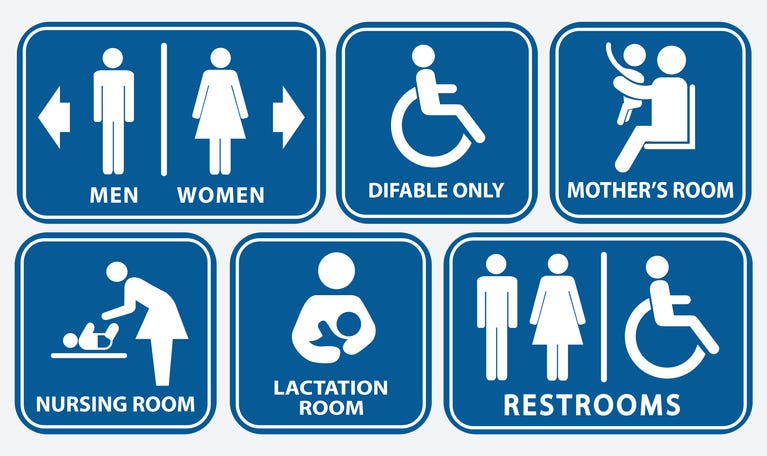The Global Impact of the International Breastfeeding Symbol
Written on
Chapter 1: The Birth of an Icon
In the early 2000s, I attended a lecture by Dr. Jack Newman, a dedicated advocate for breastfeeding for nearly four decades. He expressed concern over the pervasive use of baby bottles as cultural representations of parenting and infant care. The imagery of baby bottles is prevalent in our society, appearing on gifts, wrapping paper, decorations, and children’s literature. These images are even found in public spaces, such as airports, to signify family-friendly environments.
As noted by the World Health Organization (WHO), this prevalent symbolism diminishes the importance of breastfeeding and encourages the reliance on breast-milk substitutes. Research indicates that exclusively breastfed infants are 14 times less likely to die than those who are not. Yet, only 41% of infants aged 0 to 6 months are exclusively breastfed, a statistic the WHO aims to improve to at least 50% by 2025. The marketing of breast-milk substitutes continues to pose challenges to enhancing breastfeeding rates, a situation further exacerbated by the COVID-19 pandemic.
In 2006, we sought to change this narrative by hosting a competition through Mothering magazine to create an International Breastfeeding Symbol. Our goal was to raise public awareness about breastfeeding, identify breastfeeding-friendly locations, and provide an alternative to the baby bottle imagery.

Chapter 2: Crafting a Universal Symbol
The International Breastfeeding Symbol was designed to align with existing signage created by the US Department of Transportation and the American Institute of Graphic Artists (AIGA). The final design was chosen based on public votes, feedback from breastfeeding organizations, and the ease of reproduction. Matt Daigle, a freelance graphic designer and stay-at-home dad, created the winning design, which he has made available in the public domain for unrestricted use.
When it was first introduced, the symbol was recommended for use in large public areas where people spend significant time, such as airports, malls, and amusement parks, to identify breastfeeding-friendly spaces. Over the years, the symbol's presence has grown significantly, now recognized globally for indicating family-friendly areas. Activism surrounding the symbol has led to the establishment of breastfeeding rooms in all major US airports, a movement that began with significant protests in 2006.
The video titled "International breastfeeding symbol ornament" showcases the symbol's impact and significance in promoting breastfeeding awareness.
Chapter 3: The Symbol's Role in Public Spaces
While many public venues are accommodating to breastfeeding, finding a suitable, quiet space in busy locations like airports can be challenging. Breastfeeding rooms are not designed to segregate nursing mothers but to better integrate breastfeeding into society by providing necessary accommodations. Ideally, these spaces should include comfortable seating, changing tables, and power outlets for electric breast pumps.
The International Breastfeeding Symbol serves as a vital tool for political advocacy as well. It can be employed to support legislation for breastfeeding in public, workplace protections, and the identification of breastfeeding-friendly establishments. Maintaining a consistent visual identity for the symbol is crucial for its recognizability.

Chapter 4: The Importance of Breastfeeding
The consequences of not breastfeeding are serious. Globally, increased breastfeeding rates are linked to improved public health outcomes, with exclusive breastfeeding capable of reducing under-five mortality significantly. The WHO recommends breastfeeding for a minimum of two years, while the American Academy of Pediatrics advocates for exclusive breastfeeding for six months.
Despite widespread support from healthcare professionals, many women face barriers that hinder their breastfeeding success, including insufficient support, workplace challenges, and misinformation from the formula industry. For instance, in 2007, a significant percentage of US hospitals distributed free formula gift bags to new mothers, which was found to correlate with lower exclusive breastfeeding rates. However, by 2015, many hospitals had reversed this trend, largely due to the Ban the Bags initiative.
Although the US has one of the lowest initiation rates for breastfeeding among developed nations, the rates are gradually improving. Currently, 84.1% of women start breastfeeding, but only 58.3% maintain exclusive breastfeeding at three months. Research indicates that supportive state laws are linked to higher breastfeeding rates, yet many states still lack protections for breastfeeding in the workplace, and only a quarter of US companies offer lactation programs or accommodations for breastfeeding mothers.